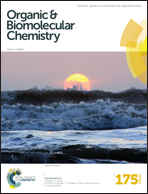A selective calix[6]arene-based fluorescent chemosensor for phosphatidylcholine type lipids†
Abstract
The development of chemosensors that can selectively detect phosphatidylcholines (PCs) in biological samples is of medical relevance considering the importance of these phospholipids in cell growth and survival. Their selective sensing over phosphatidylethanolamines (PEs) is however a challenging task. We report here on the chemosensing capacities of calix[6]tris-pyrenylurea 1, which is able to selectively interact with phosphatidylcholine-type lipids in organic media. Host 1 also binds them in a biphasic chloroform/water solution, opening the way to the design of selective chemosensors for these lipids in biological media. The results obtained by NMR, fluorescence spectroscopy and modelling studies show that the selectivity is the result of the high degree of complementarity between the lipids’ zwitterionic phosphatidylcholine headgroup and the receptor's H-bonding donor site and hydrophobic pocket. The mode of recognition is reminiscent of natural systems, such as human phosphatidylcholine transfer proteins (PC-TPs), validating the biomimetic approach adopted in our work.
![Graphical abstract: A selective calix[6]arene-based fluorescent chemosensor for phosphatidylcholine type lipids](/en/Image/Get?imageInfo.ImageType=GA&imageInfo.ImageIdentifier.ManuscriptID=C6OB01880G&imageInfo.ImageIdentifier.Year=2016)

 Please wait while we load your content...
Please wait while we load your content...